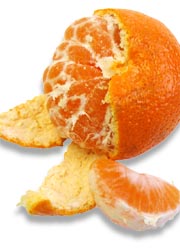
Eleanor Nakama-Mitsunaga
![]()
|
No longer are we limited to enjoying mandarin oranges exclusively from a can. Fresh mandarin oranges are abundant this time of year, but with the many hybrids and varieties on the market, sorting them out can be confusing.
The basics: Mandarins are a class of oranges defined by a thin, loose peel and easily divided segments. The group is often referred to as tangerines, but technically tangerines are a member of the mandarin group.
Mandarins are considered native to China, Southeast Asia and the Philippines and have been cultivated for thousands of years. Two popular varieties now in season are the Satsuma and Clementine. Both are relatively small, but very sweet and juicy, and virtually seedless.
The Clementine was introduced to Florida in the early 1900s and the Satsuma has thrived in southern Japan for about 350 years. About 100 varieties of Satsuma are grown in Japan and several varieties in the United States. Most canned mandarins are of the Satsuma variety.
Mandarins are a good source of vitamins A and C.
Selecting: Mandarin oranges are ripe at the time of harvesting. Choose fruit that is heavy for its size. Look for skin that is bright orange and watch out for soft spots and blemishes.
Storing: Mandarin oranges make a great centerpiece and can be piled in a bowl or left on the counter or table for several days to a week. Their shelf life is shorter than navel oranges, however, so refrigerate them for longer storage.
Use: Because mandarins are so juicy and easily peeled, they are often gobbled up immediately. They can also be segmented and added to salads, or served with puddings, gelatins or cakes.
Where to buy: The Satsuma and Clementine season generally begins in the fall and ends sometime in the spring. Most supermarkets have them in stock now, or try Costco, where they are sold by the box. Prices generally run $1 to $2 a pound.
Eleanor Nakama-Mitsunaga is
a free-lance food writer. Contact her
online through features@starbulletin.com


